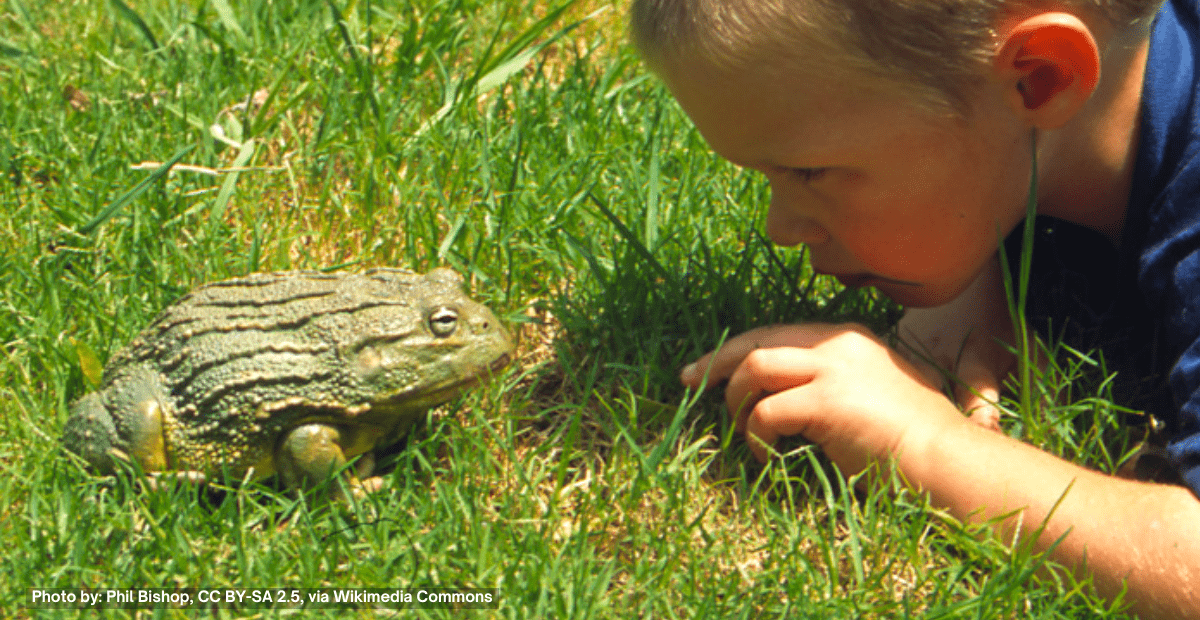The Pixie frog or African bullfrog, scientifically known as Pyxicephalus adspersus, holds the moniker of the Giant bullfrog or the South African burrowing frog. This fascinating species belongs to the family Pyxicephalidae and is renowned for its colossal size, making it the second-largest frog globally and the largest amphibian in sub-Saharan Africa.
This blog post gives you what you probably want to know about the world of the Pixie Frog—exploring its habitat, appearance, habits, reproductive strategies, conservation status, and its existence as a pet.
Where do Pixie Frogs live?
Distribution and Habitat

The Pixie frog calls the open grasslands of sub-Saharan Africa home, with its range spanning across Angola, Botswana, Kenya, Malawi, Mozambique, Namibia, South Africa, Tanzania, Uganda, Zambia, Zimbabwe, and possibly the Democratic Republic of the Congo. These frogs have adapted to thrive in various environments, from moist to dry savannas, subtropical to tropical dry shrublands, intermittent freshwater lakes, and marshes to arable land, pastureland, canals, and flooded ditches.

Despite its wide distribution, the Pixie frog faces challenges in certain regions. It has been extirpated from Eswatini and is considered “near threatened” in South Africa due to habitat loss.
How big can Pixie Frogs get?
Physical appearance

The Pixie frog is a true giant among amphibians. Males can weigh up to a hefty 1.4 kg (3.1 lb) and reach a length of 24.5 cm (9.6 in) from snout to vent.

Surprisingly, females are only half the size of males, a rarity among amphibians where females are generally larger.
The dorsum of adults displays a dark olive-green color, while juveniles boast bright green coloration with a yellow stripe down their back. The abdomen varies from white to creamy-yellow, with breeding males exhibiting yellow forelimbs.
What do Pixie Frogs eat?
Diet
The Pixie frog is a voracious carnivore with a diverse diet that includes insects, other invertebrates, small rodents, reptiles, small birds, fish, and even other amphibians.
Notably, this species exhibits cannibalistic behavior, with males known to consume the tadpoles they guard occasionally.
Remarkably, there are records of Pixie frogs consuming 17 juvenile Rinkhals snakes at the Pretoria Zoo in South Africa.
Reproductive Strategies

Breeding for the Pixie frog typically commences after receiving around 65 mm (2.6 in) of rain over two days. Breeding sites include shallow, temporary water bodies like pools, pans, and ditches. The males employ two distinct strategies based on their age. Young males congregate in small areas, while larger males occupy the center, engaging in territorial disputes. The dominant male’s goal is to prevent other males from breeding. Females approach the group, and the dominant male ensures mating success.
Females lay a substantial number of eggs (around 3,000 to 4,000) in shallow pond edges. The male guards the tadpoles, displaying overprotective behavior, even digging canals to move them to safer locations. Tadpoles metamorphose within three weeks, and the father continues to guard them until they are self-sufficient.
Are Pixie Frogs endangered?
Conservation status
The Pixie frog is currently listed as “least concern” globally. However, in South Africa, the Pixie Frog faces the threat of habitat loss, leading to its “near threatened” classification.
Intriguingly, Pixie frogs have found a place in the exotic pet trade, with captively bred animals living up to 35 years. As pets, they are easygoing but not particularly fond of human handling, displaying a tendency to bite when stressed.
Can I have a Pixie Frog as a pet?
You can, but you probably shouldn’t. In this blog, we don’t really stand behind keeping wildlife as pets. If you choose to ignore our advice, you can follow these recommendations to at least give it quality of life.
Conclusion
In summary, the Pixie Frog, scientifically known as Pyxicephalus adspersus, is a remarkable amphibian renowned for its colossal size, earning it the title of the second-largest frog globally and the largest amphibian in sub-Saharan Africa. Despite its widespread distribution across the grasslands of sub-Saharan Africa, the Pixie Frog faces conservation challenges, with a “near threatened” status in South Africa due to habitat loss and extirpation in Eswatini.
Conservation efforts are crucial to preserve the Pixie Frog’s natural habitat and ensure its continued existence. While captively bred Pixie Frogs can live up to 35 years, ethical considerations and the species’ conservation status highlight the importance of responsible wildlife management. The Pixie Frog stands as both a cute huge frog and a reminder of the delicate balance required to protect and appreciate our natural world.
If you want to know more about animals, you can go here!


One response to “The Pixie Frog: A guide on the 2nd largest frog in the world”
[…] The Pixie Frog = Cute Giant Frog […]